Experience the Frontiers of Research and Development! New Permanent Exhibitions Opening to the general public on April 23, 2025
“Quantum Computer Disco” “The Universe: Unread Messages”
The National Museum of Emerging Science and Innovation ("Miraikan"; Director: Asakawa Chieko, Ph.D.) will open two, new permanent exhibitions to the public on Wednesday, April 23, 2025: "Quantum Computer Disco" and "The Universe: Unread Messages." These exhibitions offer visitors an engaging experience of cutting edge, grand-scale research and development for the future.
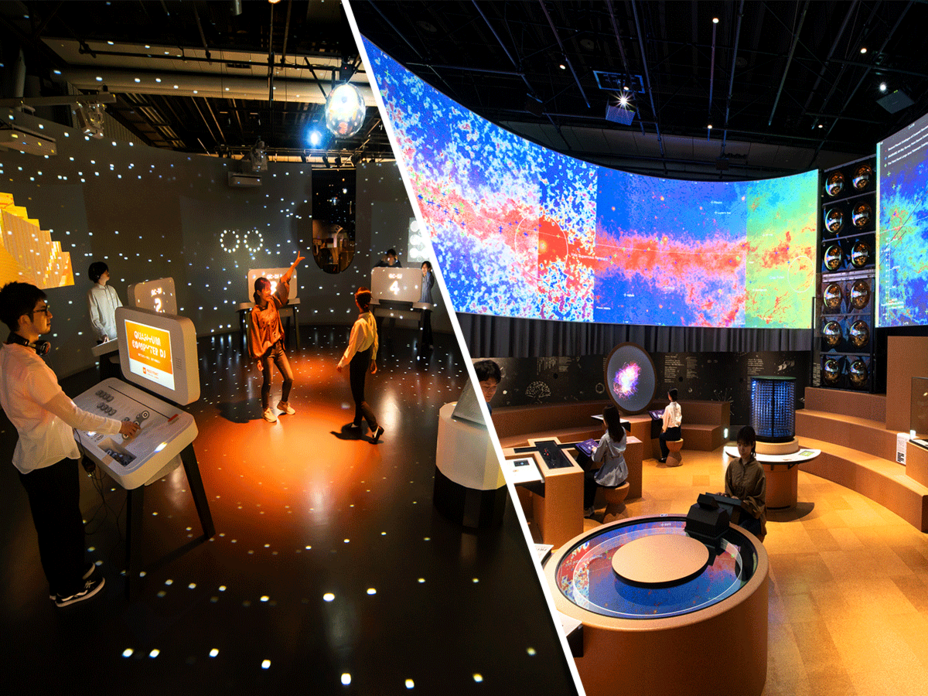
"Quantum Computer Disco" is an exhibition that helps visitors understand quantum computers in an intuitive and enjoyable way. Visitors can experience quantum programming through DJ-like operations where they select and play music on the floor, making the mechanisms of quantum computers fun to learn about. The exhibition also provides easy-to-understand explanations about the origins of quantum computers, their research history, and the latest developments. Additionally, as a result of recent research and development, a 144-qubit integrated circuit chip used in superconducting quantum computers will be publicly displayed in Japan for the first time.
"The Universe: Unread Messages" is an exhibition where visitors can experience how researchers interpret the universe using huge observation and experimental equipment. Inside the exhibition space surrounded by powerful visuals created from actual observation and experimental data, visitors can engage with four cutting-edge research approaches to understanding the universe through interactive equipment: multi-wavelength observation that captures the universe through various wavelengths of light, neutrino observation, gravitational wave observation, and accelerator experiments. Visitors will sense humanity's accumulated knowledge while being fascinated by the profound mysteries of the universe that remain "unread."
At the press preview held prior to the public opening, Director Asakawa stated, "We aimed to create exhibitions where both children and adults can feel connected to cutting-edge science. We hope that the exhibition experience will spark interest in ongoing research and development."
"Quantum Computer Disco"
It is said that "quantum computers" will bring innovation to various fields once realized, thanks to their extraordinary computational power. In this exhibition, visitors can enjoy understanding these complex future computers by interacting with one in the same way a DJ mixes music – experiencing programming that makes use of the principles of quantum mechanics. The exhibition introduces a variety of topics related to quantum computers through interactive displays and videos, from quantum mechanics—the source of quantum computers' computational power—to hardware research, computer history, and practical applications. Visitors will be able to truly feel the potential of quantum computers that will shape our future.
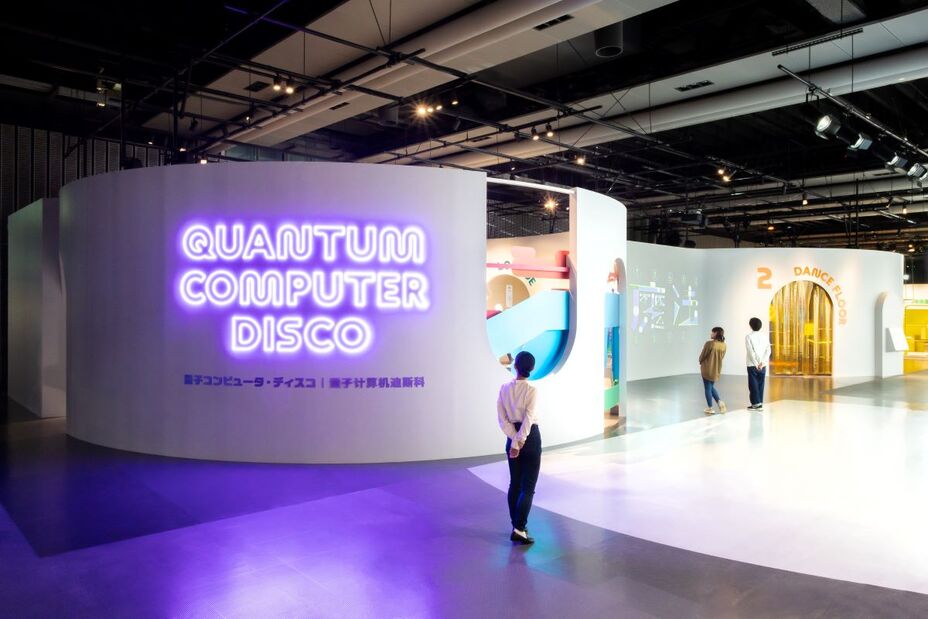
ZONE1 「ENTRANCE」
The "Quantum Computer Song" welcomes visitors. This rap, filled with keywords like "superposition" and "entanglement," invites visitors into the mysterious world of quantum mechanics.
ZONE2 「DANCE FLOOR」
Visitors can experience programming for quantum computation through DJ-like controls. Quantum computation involves placing "gates" that perform operations, similar to arranging notes on a music sheet, and then gradually approaching the correct answer through trial and error. In the exhibition, visitors can understand calculation methods using quantum properties such as "superposition," "phase," "entanglement," and "measurement" through the process of a DJ listening to, selecting, and playing music on the floor. Visitors can feel the computational power of quantum computers' "superposition," which is completely different from current computers that calculate options one by one.
Highlight: Using Many Familiar Hit Songs
The Dance Floor music experience includes many familiar hit songs including anime songs and video game music.
Visitors experience the world of quantum computer programming along with familiar and enjoyable music.
Examples of songs used: CHA-LA HEAD-CHA-LA / Dragon Quest Overture / A Cruel Angel's Thesis / September / Pachelbel's Canon / Pomp and Circumstance / Korobeiniki / Heigh-Ho / One More Time / and more
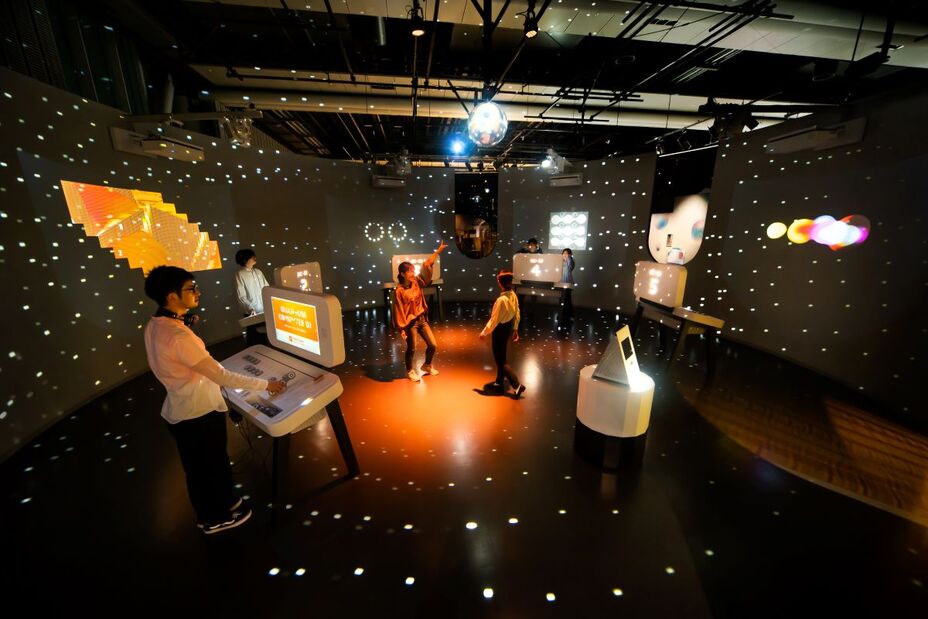
ZONE3 「GALLERY」
Four short movies explain the basics of understanding quantum computers, answering questions like "What exactly is a quantum computer?" and "Why are they being developed?" The exhibition also introduces scenes from various works including science fiction, movies, music, and games that reflect the properties of quantum mechanics and quantum computers. Visitors can feel connected to the mysterious world of quantum mechanics through expressions of "quantum computer-like" concepts such as "entanglement" and "observation" hidden in various works.
ZONE4 「LOUNGE」
This zone provides clear explanations about quantum computers, from basics to applications. Visitors can deepen their understanding by connecting the music experience from the Dance Floor to the mechanisms of quantum computers. The zone has three exhibits:
1.How Quantum Computers Are Made
First, the exhibition introduces the technological development for realizing quantum computers in three steps.
①The Material Is “Qubits”
This section explains the basic concept of "qubits," the minimum unit of information in quantum computers, and compares them with the bits used in classical computers.
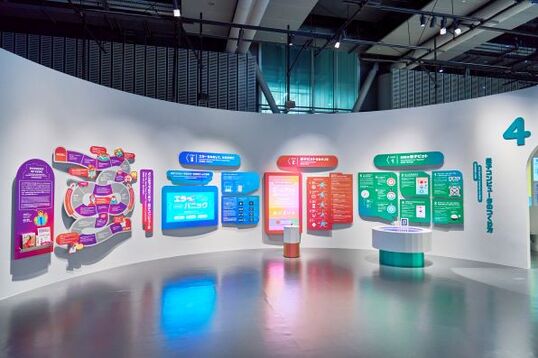
②Controlling Qubits
Next, this section introduces five methods (superconducting loops, silicon quantum dots, neutral atoms, trapped ions, and photonics) being developed worldwide. Under the supervision of experts in each field, the performance and the current status of each method are explained while comparing them using animation and radar charts.
③Correct Errors and Start Computing
Finally, "error correction" is one of the challenges that must be overcome for the practical use of quantum computers. The computers we use today also became usable and reliable by establishing methods for error correction. Here, visitors can understand the mechanism of error correction through games.
Following these three steps is a game board-style panel titled "How Far Have They Come? Quantum Computers," that summarizes the journey to realizing quantum computers. Visitors get an overview of quantum computers’ developmental progress and path to practical usage. The journey includes a "NOW!" sign indicating the current state of development, which will be updated regularly to monitor the "current" state of research and development with visitors.
2.The Story of Computation and Physics Reuniting ―The Birth of Quantum Computers
Quantum computers could be described as computers created from a fusion of computer science and physics. Focusing on the trends in "computation" and "physics," this exhibit traces the history of computers – from analog computers of the past to the development of current computers –as well as the birth of quantum computers and the ongoing race to develop them. The exhibition uses LEGO® bricks to recreate models of four computers representing different eras, including the world's first general-purpose electronic computer developed in 1946, up to the superconducting quantum computers currently under development. Visitors can see at a glance how computers have become smaller over time and get a sense of the current size of quantum computers. This exhibition helps visitors gain deeper knowledge of how quantum computers came into being and how they will develop in the future, aiding in imagining the future.
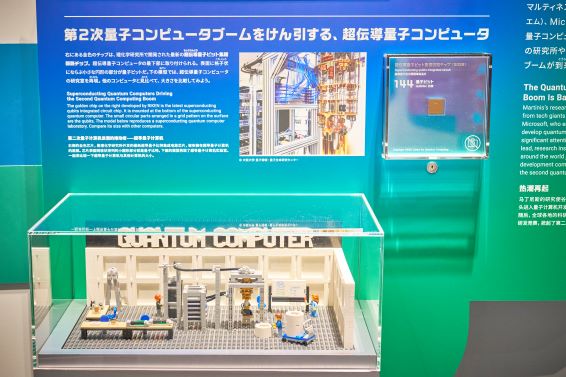
Highlight: First public display in Japan of a Japanese-made 144-qubit chip
Quantum chips govern the computational capabilities of quantum computers. Thanks to the cooperation of the RIKEN Center for Quantum Computing, a Japanese-made, "144-qubit chip" will be displayed to the general public for the first time in Japan.
3.What Can Quantum Computers Do? Gacha
Experts have answered over 100 questions about quantum computers submitted by the public. With questions covering basic curiosities to applications, visitors can find opportunities to think about quantum computers and our future, from simple questions like "Can quantum computers solve any problem?" to "Can they further evolve AI?"
Comment from Supervisor FUJII Keisuke
"Through the unique approach of likening quantum programming to a DJ experience, we have been able to create an exhibition where even those unfamiliar with quantum mechanics or quantum computers can feel their essence while having fun. Quantum computers are being researched and developed around the world toward realization, and the speed at which they are progressing is remarkable. I hope that for many who experience this exhibition, it will become a place to imagine a future that quantum computers will bring, to discuss what possibilities exist, and to consider their own relationship with quantum computers."
The Universe: Unread Messages
This is an exhibition where visitors can experience how researchers attempt to interpret the universe by using huge and varied observations, and experimental equipment. In addition to multi-wavelength observation that captures the universe through various wavelengths of light, the exhibition introduces the frontiers of the universe that researchers are exploring, including accelerating observations of "neutrinos," and "gravitational waves" in recent years, as well as large-scale experiments using particle accelerators. While being amazed at these grand, detailed research efforts that far exceed the imagination, visitors can also become familiar with the allure of a universe that still remains "unread."
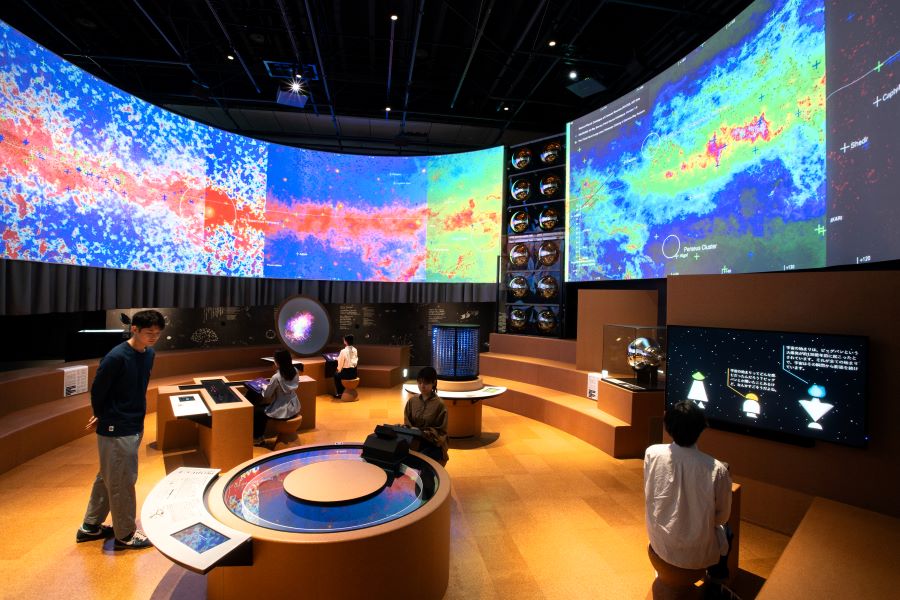
Prologue
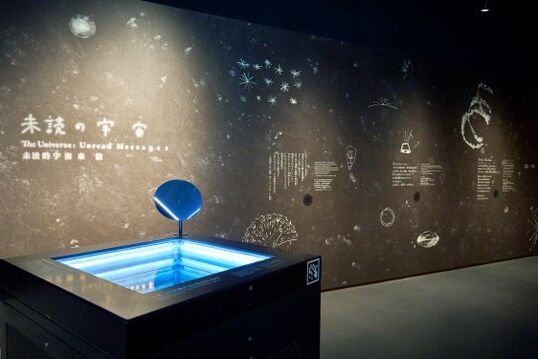
This is a passage-like space where visitors can expand their imagination toward the universe and science from the perspective of "I" as an individual. A "cloud chamber" visualizes invisible particles flying all around us, and poems and illustrations that talk about the relationship between our daily lives and matter, celestial objects, and the universe. Visitors are invited into the world of the latest universe research, as if reading a story. One of the first thing that greets visitors is a recitation from a well-known poem entitled,“Spring and Asura: Prologue” by the celebrated Japanese poet and writer Miyazawa Kenji (1896-1933).Although written about 100 years ago, it contains rich imagery that somehow connects visitors to the world of elementary particles. The recitation from the wall is performed by actor Ikematsu Sosuke and model/singer Koda Miyako.
Highlight: Popular Exhibit "Cloud Chamber" Updated
The "cloud chamber" allows visitors to see tracks of high-energy particles as they rain down from space, as well as the natural radiation contained within the atmosphere. The cloud chamber, which has previously been exhibited at Miraikan and has many fans, has been updated to the latest model for this exhibition. The window is now approximately four times larger, making it easier to observe the trajectories of cosmic rays (muons) arriving from space.
Main Area
Four characteristically shaped interactive devices are arranged in an elliptical exhibition space covered by a 360 degrees screen overhead. The immersive feeling makes visitors want to contemplate the universe across space and time, talk with others, and linger indefinitely, just like people who have been looking up at the night sky and investigating it since ancient times.
1. Multi-Messenger Vision: Feeling the Universe through Data
Neutrinos, gravitational waves, and light of various wavelengths, including those outside the visible spectrum, deliver information from the universe to us, serving as "messengers." This screen, that wraps 360 degrees around the exhibition space, displays images created based on actual observation and experimental data from each messenger. Leading media artists have engaged with vast amounts of observational data, reinterpreted the act of research, and turned it into artwork. The exhibition also visualizes the historical observation processes that established the approach of "multi-messenger astronomy," which has been moving forward in recent years as an approach to understand the universe comprehensively by combining multiple data. Visitors can intuitively understand its significance.
Highlight: Artists Creating Works Based on "Raw Data" from Observations
These works are based on the "raw data" obtained by researchers through observation. Visitors re-experience how researchers find messages from the universe, and interpret the universe from data that includes noise. The persuasiveness of the data, and the expressive power that only artists can realize, create a powerful visual experience with new discoveries every time you encounter it.
2. Four Interactive Devices: Exploring the Universe with Scientists
The exhibition introduces four observational and experimental approaches to understanding the universe through interactive exhibits based on the actual mechanisms of observation and experimentation. Leading scientists who supervised this exhibition appear as video-call-like images on smartphones. By operating the exhibits in sync with the videos, visitors can enjoy an experience as if they are conducting universe observations and experiments together with real scientists.

①Multi-wavelength Observation: Viewing the Universe
Various types of light, (electromagnetic waves) including visible light, radio waves, and X-rays, reach us from the universe. By using different types of light to observe and compare the same celestial object, we can examine the object in detail. In this exhibition, visitors can confirm how celestial objects such as the Orion Nebula and the Crab Nebula show different appearances when observed with infrared rays and X-rays by making comparisons from the actual data observed by ground-based, or space telescopes.
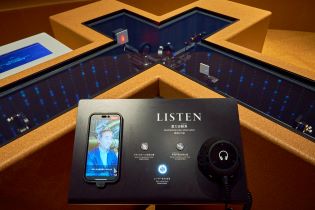
wave observation"
②Gravitational Wave Observation: Listening to the Universe
Gravitational waves are invisible "distortions of spacetime" that occur when massive celestial objects such as merging black holes move, and they can be converted into sound by analyzing their frequencies. Einstein predicted that they would be impossible to observe, but in 2015, a research project involving researchers from 15 countries around the world succeeded in the first observation. The observation uses giant laser interferometers that are more than 3km in length. This exhibition installs a real laser interferometer that miniaturizes the mechanism of the large-scale observation equipment to a 1m size. Visitors can deepen their understanding of the phenomenon where "interference fringes" created by overlapping laser light capture weak signals (vibrations) through direct observation.
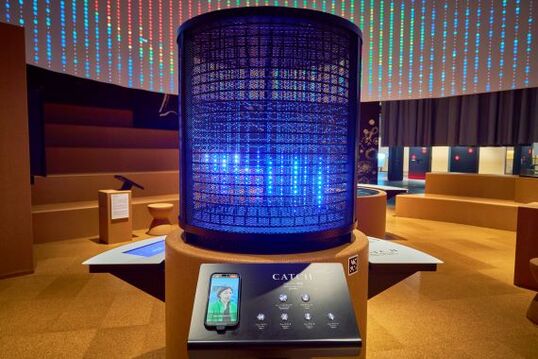
③Neutrino Observation: Catching the Universe
Neutrinos are a type of elementary particle considered to be the smallest unit of matter. Studying the properties of neutrinos is drawing attention as a clue to exploring mysteries such as cosmic rays showering the Earth. This exhibition uses scaled-down models to introduce two observation facilities, Japan's "Super-Kamiokande" and "IceCube," built under the ice in Antarctica. It also includes an actual example of the latest photomultiplier tube scheduled to be installed in the "Hyper-Kamiokande," that is currently under construction.
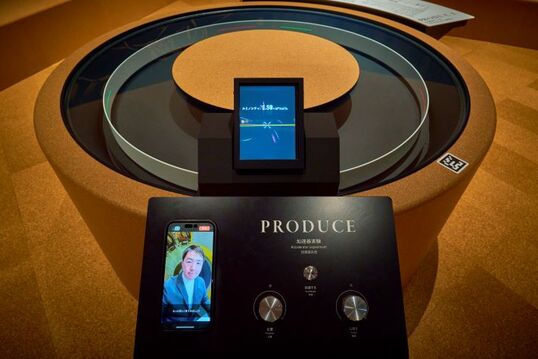
④Accelerator Experiments: Producing the Universe
The exhibition introduces particle accelerator experiments that artificially recreate the high-energy state of the early universe to determine what happened there. Using a scaled-down model of a circular accelerator, visitors can simulate experiments that accelerate and collide particles such as electrons and positrons. The exhibition also displays an actual sensor that is used to detect particles created by collisions in Japan's largest elementary particle experiment project (Belle II experiment), that involves 28 countries and regions.
3.Pondering the Universe with AI
This interactive exhibit allows visitors to freely discuss, with generative AI, questions and impressions that arise through the exhibition. Seven diverse characters created in collaboration with generative AI appear. Three characters are randomly selected from options including a knowledgeable "scientist," a "child" who gives straightforward reactions, and a character with rich life experience who expands on topics, allowing visitors to enjoy natural and expansive conversations with diverse AI characters.
Epilogue
It is common in universe research that when one mystery is solved, new questions arise. Please enjoy the lingering sensation that you yourself are also a part of the still "unread" universe. This happens while viewing panels that provide an overview of research approaching the origins and evolution of the universe, celestial objects, and matter, as well as a mural specially drawn by Shiokawa Izumi.
Comment from Supervisor KAJITA Takaaki
"In the predecessor exhibition opened in 2002, we introduced Super-Kamiokande, which observes neutrinos. After a quarter century, it is about to be succeeded by the next generation of equipment. During this time, the observation of ultra-high-energy cosmic neutrinos has begun in places like Antarctica. Gravitational wave observation has been advanced through international cooperation with Japan's participation. Plus, the foundation for multi-messenger astronomy, that captures the universe from multiple angles by collaborating with optical telescopes and multi-wavelength observations, has been established. Accelerator experiments are also being conducted to investigate the early universe that cannot be observed with light. It has been a very meaningful experience for me to be able to create an exhibition that conveys the current state of such science at Miraikan, where an ever wider group of the public visit, in cooperation with a host people. I hope that many visitors will come to see it."
